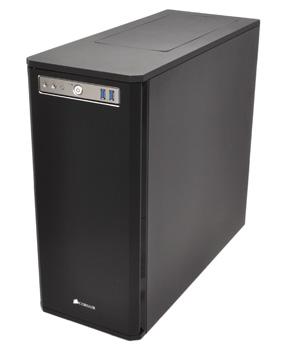Introduction
Corsair has tackled the high-performance chassis market with aplomb and it's hard to argue against the virtues of many of the manufacturer's existing enclosures. The original Obsidian 800D remains the go-to solution for builders who demand maximum size and functionality, the Graphite 600T is in our estimation still the best-looking chassis around and, if you're on a budget, the Carbide 300R is a pretty safe bet too.
Performance fiends have been well catered for, but there is one area in which all of Corsair's previous efforts have been lacking; sound proofing. Each and every Corsair chassis thus far has focussed primarily on airflow and optimum performance, with noise reduction being for the most part an afterthought. Fortunately, if you enjoy the comfort of a near-silent computing experience - and we know that many of you do - then Corsair's hoping to get your attention with the new Obsidian Series 550D.
In stark contrast to every Corsair chassis before it, the 550D - priced at around £110 - claims to have been "carefully engineered for noise reduction and sound isolation." It's a shift in focus, but not a clean cut as while keeping noise levels in check is the primary goal, Corsair isn't forgetting its core audience and adds that the 550D also offers "amazing cooling potential, lots of expansion flexibility, and the durability that Obsidian Series is renowned for."
A quiet chassis that performs well is definitely our cup of tea and at first glance the Obsidian 550D is a bit of a looker, too. The minimalist mid-tower frame stands at 531mm x 221mm x 495mm in size and is finished in a matte-black shell that's in keeping with previous Obsidian enclosures. It isn't as eye-catching as the Graphite 600T, but it is arguably more elegant.
The front I/O panel takes the form of a flush silver strip that's both attractive in appearance and modestly stocked with headset and microphone jacks, power and reset buttons and two USB 3.0 ports. The angled front corners are a nice touch, as is the entire front face - it's a brushed aluminium door that opens in either direction to reveal the optical bays and front fan filter.
The front panel is visually attractive, but the door's opening mechanism leaves something to be desired. We appreciate the fact that it can swing to the left or to the right, but it requires a bit of a yank to open - and if you pull too hard, you risk pulling the door off its hinges completely. Not a deal breaker by any means and if you do require frequent access to the optical bays, the 550D looks surprisingly smart with the front panel left off.
Round back, two push-to-release buttons are available for quick removal of the side panels. A very welcome addition and one that makes the 550D easy to get into on a regular basis.
This is a lovely-looking case, but one that we reckon could have been made even more attractive. You see, by attempting to tackle quiet computing and high performance in one fell swoop, Corsair has introduced a couple of imperfections that detract from the otherwise sleek design. The strange-looking cutout in the left side panel, for example, that's a push-to-release vent that reveals access to an additional two 120/140mm fan mounts.
It's the same on top, where it could have been a single, sleek matte-black body but is instead a panel with a covered vent that provides room for a further two 120/140mm fans or a 240mm radiator (including Corsair's own Hydro H100). The idea itself is sound - there's a lot of extra cooling potential should you need it - but if you don't, you might have preferred uninterrupted panels all round, and the problem's emphasised by the fact that the two vents don't quite sit perfectly flush with the chassis.
Corsair, it seems, isn't going to give up its high-performance heritage easily. Although the Obsidian 550D is designed to be quiet, it also ships with three pre-installed fans and can accommodate up to 10 in total.
In addition to the included two 120mm front intakes and rear 120mm exhaust, this chassis can house another two 120mm intakes behind the hard-disk cages, a bottom 120/140mm intake, two 120/140mm intakes on the side panel and a further two 120/140mm exhausts up top. 10 fan mounts is impressive, but the fact that six of them can house 140mm fans suggests that Corsair isn't holding back in terms of airflow.
You could, in a way, call this a hybrid case. It can be configured to run quiet, but you can also load it up with fans for maximum cooling performance. Either way, it's nice to have the option and Corsair's implementation is really rather good. The front and side panels, for example, are lined with sound-deadening material and the top- and side-panel vents have sound-insulated covers to prevent noise leakage from unused fan mounts.
The sound-deadening material is reasonably thick throughout and the side, front and top vents are also lined with magnetic dust filters that peel away with ease. It's the little touches that make a good chassis a great one and there are plenty of positive signs in the 550D.
It feels well-built throughout, and like so many Corsair chassis, it's a joy to work with when you get inside.













